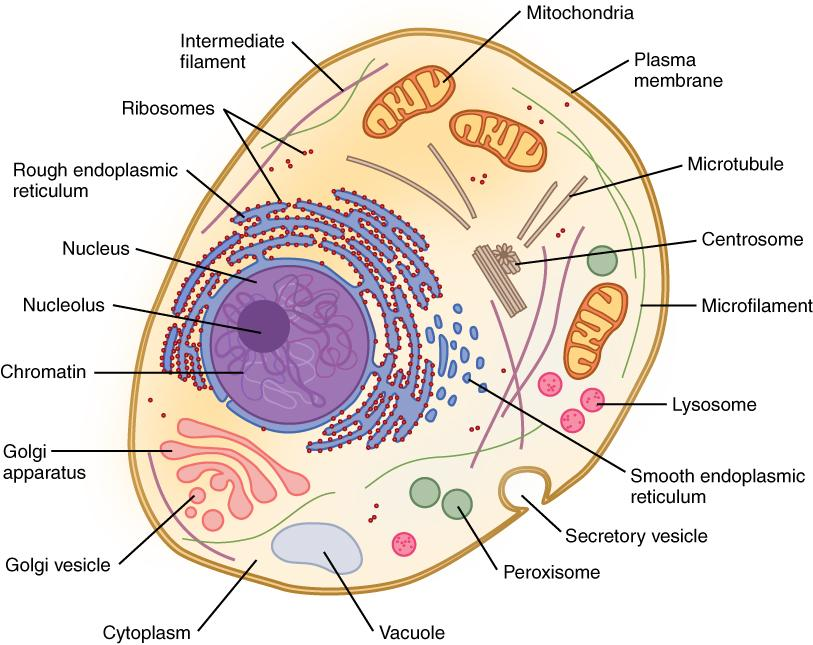
Animal cells are
A. Round and irregular in shape
B. Round or rectangular in shape
C. Regular and rectangular in shape
D. Irregular and square in shape
Answer
555k+ views
Hint: Cells are the basic building blocks of all living things. The human body is composed of trillions of cells. Unlike plant cells, animal cells lack cell walls.
Complete answer: Animal cells are eukaryotic cells, surrounded by the plasma membrane. It contains membrane-bound nuclei and organelles. Unlike eukaryotic cells of plants and fungi, animal cells do not have cell walls. The main difference between animal cells and plant cells is that plant cells have cell walls, while animal cells lack cell walls. The cell wall made of cellulose gives plant cells rigidity, thus forming a fixed rectangular shape. Animal cells lack rigidity, so they tend to have round and irregular shapes. The appearance of animal cells often changes greatly.

The cell wall allows high pressure to build inside the plant cell without breaking. Therefore, plant cells can receive a large amount of liquid through osmosis without breaking. Animal cells that only have membranes that restrict access to the cells tend to rupture if they absorb too much water. Cells provide structure to the human body, absorb nutrients from food, convert these nutrients into energy, and perform specialized functions. Cells also contain the body's genetic material and can replicate itself.
Thus, the correct answer is option A.
Note: The longest cells in the human body are motor neurons. They can reach up to 4.5 feet (1.37 meters) in length and extend from the lower spinal cord to the big toe. Red blood cells carry oxygen around the body. They are created in the bone marrow of your bones.
Complete answer: Animal cells are eukaryotic cells, surrounded by the plasma membrane. It contains membrane-bound nuclei and organelles. Unlike eukaryotic cells of plants and fungi, animal cells do not have cell walls. The main difference between animal cells and plant cells is that plant cells have cell walls, while animal cells lack cell walls. The cell wall made of cellulose gives plant cells rigidity, thus forming a fixed rectangular shape. Animal cells lack rigidity, so they tend to have round and irregular shapes. The appearance of animal cells often changes greatly.

The cell wall allows high pressure to build inside the plant cell without breaking. Therefore, plant cells can receive a large amount of liquid through osmosis without breaking. Animal cells that only have membranes that restrict access to the cells tend to rupture if they absorb too much water. Cells provide structure to the human body, absorb nutrients from food, convert these nutrients into energy, and perform specialized functions. Cells also contain the body's genetic material and can replicate itself.
Thus, the correct answer is option A.
Note: The longest cells in the human body are motor neurons. They can reach up to 4.5 feet (1.37 meters) in length and extend from the lower spinal cord to the big toe. Red blood cells carry oxygen around the body. They are created in the bone marrow of your bones.
Recently Updated Pages
Master Class 12 Business Studies: Engaging Questions & Answers for Success

Master Class 12 Economics: Engaging Questions & Answers for Success

Master Class 12 English: Engaging Questions & Answers for Success

Master Class 12 Maths: Engaging Questions & Answers for Success

Master Class 12 Social Science: Engaging Questions & Answers for Success

Master Class 12 Chemistry: Engaging Questions & Answers for Success

Trending doubts
What is meant by exothermic and endothermic reactions class 11 chemistry CBSE

Which animal has three hearts class 11 biology CBSE

10 examples of friction in our daily life

One Metric ton is equal to kg A 10000 B 1000 C 100 class 11 physics CBSE

1 Quintal is equal to a 110 kg b 10 kg c 100kg d 1000 class 11 physics CBSE

Difference Between Prokaryotic Cells and Eukaryotic Cells




